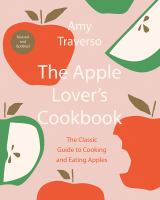
Bibliobites in October: Falling For Apples
 The jury’s still out on whether an apple a day really does keep the doctor away, but if it’s fall in New England, then it’s apples all day and every which way. Fresh or in crisp or pie, pressed into cider or cooked down into sauce, apples are endlessly versatile and uniquely delicious. This month’s title, The Apple Lover’s Cookbook by Amy Traverso, introduced us to some new ways with apples, and acquainted us with some less- common varieties that (it turns out) grow close to home.
The jury’s still out on whether an apple a day really does keep the doctor away, but if it’s fall in New England, then it’s apples all day and every which way. Fresh or in crisp or pie, pressed into cider or cooked down into sauce, apples are endlessly versatile and uniquely delicious. This month’s title, The Apple Lover’s Cookbook by Amy Traverso, introduced us to some new ways with apples, and acquainted us with some less- common varieties that (it turns out) grow close to home.
The beginning of this book features a primer (as the author calls it) of apple varieties, which was easily one of the most interesting and useful parts of the book. There are photos and descriptions of 59 apple varieties, some of which are quite common in area supermarkets, and others that we’d never seen or heard of. After reading through it, I wondered just how different in taste and texture these apples might be. 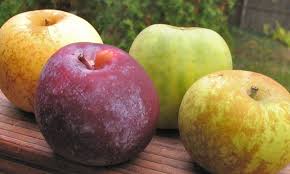 So, in the name of scientific research, I went to a local orchard and chose six heirloom varieties: Baldwin, Cox’s Orange Pippin, Jonathan, Newtown Pippin, Spencer, and Winesap. At our meeting we conducted a blind taste test, and….they all were unique! For almost all of us, Cox’s Orange Pippin was the favorite, with the Spencer a close second. Though the book’s primer lists the Pippin as a sweet apple, we thought it had plenty of tartness. Perhaps it was the balance of tart and sweet that was so appealing? The Spencer was a bit sweeter than the
So, in the name of scientific research, I went to a local orchard and chose six heirloom varieties: Baldwin, Cox’s Orange Pippin, Jonathan, Newtown Pippin, Spencer, and Winesap. At our meeting we conducted a blind taste test, and….they all were unique! For almost all of us, Cox’s Orange Pippin was the favorite, with the Spencer a close second. Though the book’s primer lists the Pippin as a sweet apple, we thought it had plenty of tartness. Perhaps it was the balance of tart and sweet that was so appealing? The Spencer was a bit sweeter than the 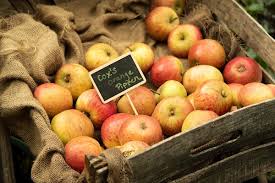 Pippin, but what we liked most about it was its satisfying crunch. Our least favorite was the Baldwin; our sample was unappealingly mushy. The primer lists this apple as a “firm-sweet,” so we can only assume it had not been recently picked. Many older apple varieties are experiencing a resurgence, so next time you’re at an orchard, check out all the possibilities. You’re sure to find a new favorite!
Pippin, but what we liked most about it was its satisfying crunch. Our least favorite was the Baldwin; our sample was unappealingly mushy. The primer lists this apple as a “firm-sweet,” so we can only assume it had not been recently picked. Many older apple varieties are experiencing a resurgence, so next time you’re at an orchard, check out all the possibilities. You’re sure to find a new favorite!
Once apple tasting was done, it was time to get down to the nitty-gritty: what did we do with all those apples? The author gave us plenty of choices, both sweet and savory. As is often the case, most of us went straight to the main dishes. Four of us made 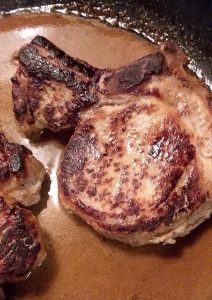 cider-brined pork chops with mustard pan sauce. The chops, brined in cider, were “very tender,” and the mustard sauce was a nice (if a bit too dominant) complement. However the whole thing “wasn’t very apple-y,” and the “flavor didn’t match the number of ingredients.” On the other hand, sausage with braised cabbage and apples had “lots of apple flavor….really good!” This hearty combination also featured caraway seeds, which are not a favorite for some! Sweet potato, apple and ginger soup was “good, but not a keeper.” This was a pleasant combination with a fairly subdued apple presence; it was similar to other soup recipes so it didn’t really stand out.
cider-brined pork chops with mustard pan sauce. The chops, brined in cider, were “very tender,” and the mustard sauce was a nice (if a bit too dominant) complement. However the whole thing “wasn’t very apple-y,” and the “flavor didn’t match the number of ingredients.” On the other hand, sausage with braised cabbage and apples had “lots of apple flavor….really good!” This hearty combination also featured caraway seeds, which are not a favorite for some! Sweet potato, apple and ginger soup was “good, but not a keeper.” This was a pleasant combination with a fairly subdued apple presence; it was similar to other soup recipes so it didn’t really stand out.
Some of the more substantial vegetable recipes could almost be main dishes: squash stuffed with apples, pancetta, and walnuts was “a keeper! Delicious!” It had beautiful layers of flavor: meaty and sweet, with a welcome sharp note from the Gorgonzola. 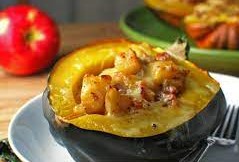 Squash and apple gratin was a bit less successful; it was just “OK.” The breadcrumb topper burned when kept under the broiler for 5 minutes, as the recipe instructed. Perhaps with less char some of the other flavors would have come through? A few other veggie dishes were big hits: cider-glazed root vegetables were “yummy….the glaze adds so much extra flavor!” And parsnip-apple puree was “not colorful but very good…the apple took away the bitter edge of the parsnips….nice balance!” And should you crave a bit of tangy, salty crunch to serve on the side, quick bread-and-butter apple pickles were a definite keeper. The combo of thinly sliced cucumber, apple, and shallot paired perfectly with the mild brine and some fresh tarragon. Easy to put together, too.
Squash and apple gratin was a bit less successful; it was just “OK.” The breadcrumb topper burned when kept under the broiler for 5 minutes, as the recipe instructed. Perhaps with less char some of the other flavors would have come through? A few other veggie dishes were big hits: cider-glazed root vegetables were “yummy….the glaze adds so much extra flavor!” And parsnip-apple puree was “not colorful but very good…the apple took away the bitter edge of the parsnips….nice balance!” And should you crave a bit of tangy, salty crunch to serve on the side, quick bread-and-butter apple pickles were a definite keeper. The combo of thinly sliced cucumber, apple, and shallot paired perfectly with the mild brine and some fresh tarragon. Easy to put together, too.
There’s a breakfast-y chapter and that appealed to many; baked apple oatmeal pudding was “pretty good….similar to others.” It was “very filling” and would be great for breakfast, or even dessert. If you’re craving a more elegant start to your day, 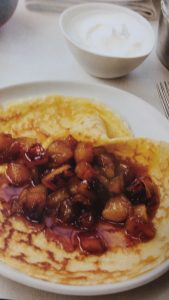 crepes filled with caramelized apples might suit, though “creme fraiche and maple syrup are expensive!” The crepe recipe was “fine” and it did make a lot. A more substantial breakfast option, sausage, apple, and cheddar strata was unfortunately “disappointing.” The casserole was overall too soft and “needed more body.” It’s possible that the bread used was not sturdy enough. Worth a repeat?
crepes filled with caramelized apples might suit, though “creme fraiche and maple syrup are expensive!” The crepe recipe was “fine” and it did make a lot. A more substantial breakfast option, sausage, apple, and cheddar strata was unfortunately “disappointing.” The casserole was overall too soft and “needed more body.” It’s possible that the bread used was not sturdy enough. Worth a repeat?
In the baking department, apple pumpkin walnut muffins were a hit with their classic fall flavors and spices. The recipe makes 15 standard-size muffins, so it’s a good choice for a crowd. Cider donut muffins were also a hit and did taste just like a cider donut. These baked treats were “not too sweet” and had prominent cider notes, “I would make again!” Oatmeal topped apple crisp was “demolished” at a potluck, which is as good an endorsement as any. The classic oat/nut/spice topper was a winner. Apple apricot kuchen also went to a party, where it “disappeared!” This “easy” dessert was “really good,” though it needed more bake time than the recipe indicated. 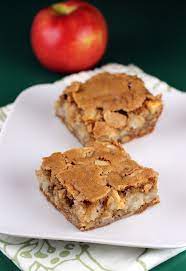 Apple brownies were also a quick and easy treat. It was “best when fresh but still good left over,” and earned keeper status. A very similar cake, simple apple nut cake was much less successful. Though it was tasty and apple-y when first baked, it turned into a wet mess after a day. The apples exuded so much moisture that the cake became an inedible sodden pudding. In comparing the brownie and cake recipes (conveniently on facing pages of the book), about the only difference is that the cake calls for 50% more apples than the brownies, which may have been the culprit. Applesauce is yet another tasty classic that will easily use up any apple surplus you may have; orange-scented spiced applesauce had a pleasing spice combo of cinnamon and cloves, though the orange flavor “wasn’t strong enough.”
Apple brownies were also a quick and easy treat. It was “best when fresh but still good left over,” and earned keeper status. A very similar cake, simple apple nut cake was much less successful. Though it was tasty and apple-y when first baked, it turned into a wet mess after a day. The apples exuded so much moisture that the cake became an inedible sodden pudding. In comparing the brownie and cake recipes (conveniently on facing pages of the book), about the only difference is that the cake calls for 50% more apples than the brownies, which may have been the culprit. Applesauce is yet another tasty classic that will easily use up any apple surplus you may have; orange-scented spiced applesauce had a pleasing spice combo of cinnamon and cloves, though the orange flavor “wasn’t strong enough.”
Most of us enjoyed this book. Though there weren’t many revelations in the recipe department (it was published in 2014), the apple information, particularly the primer, was much appreciated, and we did come away with some new ideas and a few keepers. We liked the author’s friendly and straightforward voice; in particular we liked her detailed instructions. Since this title is almost ten years old, it did not have enough photos to satisfy a 2023 reader, though the photos we had were good ones. This book has a “revised and updated” version published in 2020. It’s not much different than the original, though it does have about a dozen additional recipes and some extra photos. When it came to the votes, we averaged out to a 3.4 (out of a possible 5). That’s a pretty good score for this group, and reflects our appreciation of the author’s wide-ranging apple knowledge.
Join us at our next meeting on Friday, December 1 at 11 AM in the Fireplace Room. Please note, this is a combined November/December meeting. We’ll be discussing chef Marcus Samuelsson’s classic memoir, Yes, Chef, as well as one of his cookbooks, Marcus Off Duty: The Recipes I Cook at Home. Happy Thanksgiving to all, and see you on the 1st!






